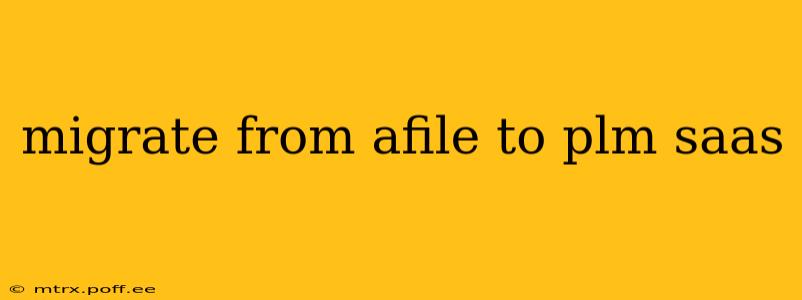Migrating from a legacy system like aFile to a modern PLM (Product Lifecycle Management) SaaS solution is a significant undertaking, but the rewards—improved collaboration, streamlined processes, and enhanced data management—make it worthwhile. This guide will walk you through the key considerations and steps involved in a successful migration.
What is aFile and Why Migrate to PLM SaaS?
aFile, while functional for some, often lacks the scalability, collaboration features, and robust data management capabilities of a modern PLM SaaS solution. PLM SaaS offers centralized data storage, improved version control, enhanced collaboration tools, and seamless integration with other business systems. This translates to reduced errors, improved product development cycles, and better overall product quality. The cloud-based nature of SaaS also eliminates the need for expensive on-site infrastructure and IT maintenance.
Key Steps in Migrating from aFile to PLM SaaS
The migration process can be broken down into several key phases:
1. Assessment and Planning: Understanding Your Current State
Before you begin, a thorough assessment of your current aFile environment is crucial. This includes:
- Data Inventory: Identify the types and volume of data stored in aFile, including documents, revisions, and metadata.
- Process Mapping: Document your current product development processes and how they rely on aFile.
- User Needs Analysis: Gather requirements from users to understand their expectations from the new PLM system.
- PLM Selection: Choose a PLM SaaS solution that meets your specific needs and integrates seamlessly with your existing systems. Consider factors like scalability, security, and user-friendliness.
- Resource Allocation: Identify the team members responsible for the migration and allocate the necessary resources (time, budget, and expertise).
2. Data Migration: Moving Your Data Safely and Efficiently
Data migration is the most critical and complex phase. Key aspects include:
- Data Cleansing: Before migration, clean your aFile data to ensure accuracy and consistency. This may involve removing duplicates, correcting errors, and standardizing metadata.
- Data Mapping: Map your aFile data fields to the corresponding fields in the PLM SaaS solution. This ensures data integrity during the transfer.
- Migration Strategy: Choose a migration strategy that minimizes downtime and data loss. Options include phased migration, parallel run, and big bang migration. A phased approach is generally recommended for minimizing disruption.
- Data Validation: After migration, thoroughly validate the data to ensure accuracy and completeness.
3. System Configuration and Testing: Ensuring Seamless Functionality
Once the data is migrated, the PLM SaaS system needs to be configured to match your specific business processes. This includes:
- Workflow Configuration: Set up workflows to automate tasks and improve collaboration.
- User Roles and Permissions: Assign appropriate roles and permissions to users to ensure data security and access control.
- Integration with Other Systems: Integrate the PLM system with other business systems, such as ERP and CRM.
- User Training: Provide comprehensive training to users on the new system to ensure smooth adoption.
- Testing: Thoroughly test the system to identify and resolve any issues before go-live.
4. Go-Live and Post-Implementation Support: Ensuring Ongoing Success
After thorough testing, you can proceed with the go-live phase. This involves:
- Phased Rollout: Consider a phased rollout to minimize disruption and allow for adjustments based on user feedback.
- Change Management: Communicate effectively with users throughout the migration process to manage expectations and address concerns.
- Post-Implementation Support: Provide ongoing support and maintenance to ensure the continued success of the PLM system.
Frequently Asked Questions (FAQs)
How long does aFile to PLM SaaS migration take?
The duration varies significantly based on the size and complexity of your aFile data, the chosen PLM system, and the migration strategy. It can range from a few weeks to several months.
What are the potential challenges of migrating from aFile to PLM SaaS?
Challenges can include data cleansing, data mapping, system integration, user adoption, and unexpected technical issues. Thorough planning and testing can mitigate many of these challenges.
What is the cost of migrating from aFile to PLM SaaS?
The cost depends on factors like the size of your data, the complexity of the migration, the chosen PLM solution, and the level of external support required. It's essential to obtain detailed quotes from PLM vendors.
Can I migrate only parts of my aFile data?
Yes, a phased approach allows for migrating specific data sets or modules initially, gradually expanding the migration scope over time.
By following these steps and carefully addressing the potential challenges, you can successfully migrate from aFile to a PLM SaaS solution, reaping the benefits of improved efficiency, collaboration, and data management. Remember, thorough planning, effective communication, and robust testing are crucial for a smooth and successful migration.
